When I learned how to meditate, counting was not important. But I still wanted to wear beads because that’s what the yogis wear, right? It may have been immature reasoning at first, but as I learned more and received further initiations, the beads became much more important.

In India, a mala is a string of special beads which, like a rosary, is used for the chanting of one's mantra. A mala is generally worn around the neck and contains 108 beads. Some types of mala are shorter and used only to count, and are often kept inside a small bag so that the beads remain clean and the japa (counting practice) remains private.
A mala is traditionally made of rudraksha beads, tulsi, spatik (crystal), chandan (sandalwood) or lotus seeds. Malas have now become an accessory product in what is called 'the yoga industry'. Such malas are often mass-produced with imitation gemstones and plastic rudraksha beads, used only for fashion. In this article I will go over the different types of authentic malas, their use and importance, featuring the handmade, ethically sourced and spiritually sensitive malas.
RUDRAKSHA
Rudraksha literally means “tears of Rudra”, and Rudra is a name of Lord Shiva. The rudraksha mala is worn by yogis and sadhus of various ancient and important lineages in India. The seed comes from a large tree that grows in the Himalayan foothills. The fruits themselves are a stunning royal blue, and within them is the seed that is sacred to yogis and devotees of Shiva. The seeds vary from the size of a peppercorn to a whole walnut. The faces of a rudraksha seed are important for the correlation with Vedic astrology. Some, such as those with two faces or twelve faces, are very rare and expensive.
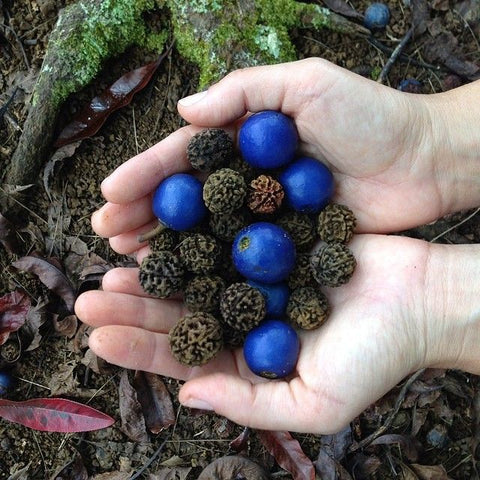
Rudraksha are said to retain holy vibrations, and are therefore often worn as necklaces. In many traditions within India, a large rudraksha bead is given by the guru to the disciple at the time of initiation.
Rudraksha malas are commonly used for counting mantras or kriyas. The great yogi Yogiraj Lahiri Mahashaya’s rudraksha mala was worn down smooth from all the times his fingers passed over the beads.
TULSI
Millions of homes in India have a small Tulsi plant in the entrance or courtyard where it is revered. Tulsi (sometimes spelled Tulasi) literally means "unmatched". This is a very sacred plant, and therefore called Holy Basil, because of its divine origin stated in various scriptures of India. It is considered very purifying.
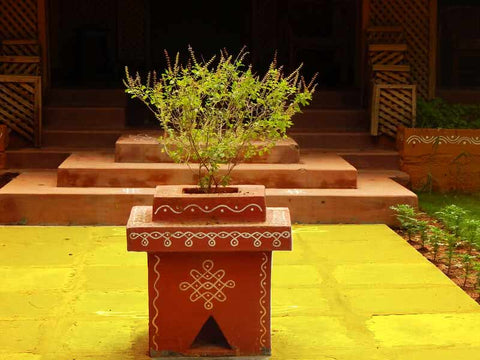
The plant is dear to devotees of Sri Rama and Sri Krishna and is used in worship to purify and bless. Its leaves are used daily in puja, or worship rituals. Tulsi Malas are most commonly worn by Vaishnavas, the devotees of Vishnu. The wood is carved into round beads of various sizes to be worn or used as malas.
Krishna Temples are an excellent places to buy Tulsi plants and japa malas. You can also find them here at this website.
SANDALWOOD
This fragrant wood, chandan, is sacred in India and has a fragrance that induces spiritual consciousness. It became world-famous and as a result was exploited, requiring the precious wood to be protected by the government of India. Some other countries are now cultivating sandalwood. The wood can be carved into beads and makes beautiful malas.
SPATIK
Spatik is crystal quartz and is associated with Devi, or the Divine Mother and Shakti, the primordial feminine life and power of all creation. It is cooling to the touch. Spatik has a unique quality in that it can take on the vibrations of any deity that is invoked into it.
SHIVA SHAKTI
The equality and union of Divine Mother and Father, Spirit and Nature, Prakriti and Purusha, Shiva and Shakti, and so on, is foundational to all of India's sacred philosophies and traditions. That is why it is common to have malas made of both Rudraksha and Spatik (quartz crystal) such as these malas.
GEMSTONES
Various gems and gemstones from all over the world are known to have different benefits. They emit certain vibrations that harmonize with the subtle body. An entire science of astrology, named Jyotish, uses special gems, metals and plants for treatments and prevention. The Rishika gemstone and bead malas created by owner of Supreme Swan, Lopamudra Bose, are exceptional. All gemstones are hand selected for their vibrational quality, and each mala is handmade in small quantities with special attention to the spiritual benefits and natural beauty. I myself have noticed a distinct quality and spiritual vibration in these malas, especially when compared to the mass-produced ‘fashionable yoga malas’ that have become very trendy.
OTHER MALAS
Other malas in various traditions of India will use malas made of lotus seeds, rosewood, or turmeric wood.
JAPA YOGA
Japa Yoga is a form of Abhyasya Yoga, stated in several verses throughout the Bhagavad Gita. Lord Krishna advises the devotee who is not permanently engrossed in God to keep trying again and again through continued, repeated practice. It’s the power of repetition.
अथ चित्तं समाधातुं न शक्नोषि मयि स्थिरम् |
अभ्यासयोगेन ततो मामिच्छाप्तुं धनञ्जय ||atha cittam samādhātum na śaknoshi mayi sthiram
abhyāsayogena tato mām icchāptum dhananjayaO Dhananjaya (Arjuna), if thou art not able to keep thy mind wholly on Me, then seek to attain Me by repeated yoga practice. (XII:9 - Translation by Paramahansa Yogananda)
Japa Yoga is the heartfelt repetition of a guru-given (not Google-given!) mantra—this mantra can be Aum, or Hong-Sau, or a mantra including a Divine Name such as to Krishna, Shiva or Kāli. Usually one ‘round’ of a japa mala is 108. Many devotees who have been given a sadhana by their guru are told to chant the mantra in a certain number of rounds, such as sixteen rounds.
MALAS FOR KRIYA YOGA AND PRANAYAMA
Other traditions chant the mantra along with a kriya or pranayam, which are active methods of controlling prana, mind and breath. Again, such a guru-given sadhana will be accompanied with instructions for how many to practice. For example, kriya yoga is not always practiced in rounds of 108, but rather in a multiple of 12 such as 24, 36, 60, 108, etc. That is why Kriya Malas have the twelfth bead marked differently. The kriya malas made by Supreme Swan are handmade and carefully designed for kriya yoga practice, often using a blend of rudraksha beads and gemstones, and marking each bead after twelve with a distinct stone or seed so that the fingers will easily feel the difference. View all Kriya and Meditation Malas here.
SMALL MALAS & WRIST MALAS
I love smaller malas because I can put them in my handbag and keep one in my car so that I can practice japa when I'm on the go. Some malas are also made to wear on the wrist, with similar benefits as the neckalce malas. Supreme Swan has numerous wrist malas of different sizes and some are specially designed with a more masculine feel. Have a look. They also serve as reminders to "practice the Presence", or continue the inner japa.
THE NUMBER 108
There are various reasons for the sacred nature of this number, depending on which tradition within India's vast spiritual heritage, which is named Sanatan Dharma, or the 'Eternal Dharma'. This includes the primary religions that later branched off from Sanatan Dharma, namely the Buddhist, Jain and Sikh dharmas. Each of the Dharma religions revere the number 108 for different reasons. It is often connected to astrology, scriptural stories of creation, and in other traditions the number has an esoteric correlation to the chakras and nadis.
ETIQUETTE
Malas are sacred, used in worship and yoga sadhana. They may be worn to carry sacred vibrations on the body, or to remind one of the Divine Presence. But most importantly, they are used for worship and sadhana. Therefore, in India there is an etiquette of respect and purity towards this sacred item, traditions that are still observed to this day. My intention in sharing this is not to be a "Miss Manners", but rather to share what I have learned with the hope of honoring these traditions that are intimately connected with the sacred objects that we are fortunate to possess.
The mala never touches the floor or any part of the lower half of the body below the waist. When seated, devotees place a shawl over their legs and then the mala can touch that. Only the right hand is used to count (unless you are left-handed), and the index finger does not touch the mala in counting. Usually one uses the thumb and ring finger. The "meru bead" is never crossed over. When one is counting in public, the mala is traditionally hidden in a mala bag or under the shawl. This is done as a safeguard against potential vanity of the devotee—thinking of others or showing off—and also to protect the devotee’s practice from the judgmental gaze of others.
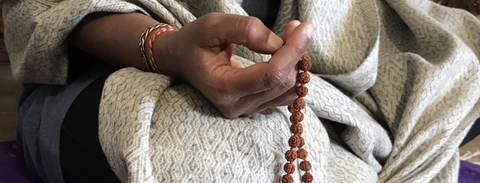
Malas can be worn inside the clothes touching the skin, or outside over the clothes. Wrist malas must be kept clean and removed before any actions that would dirty them. Malas are removed before using the toilet. Malas are cleaned frequently and can be rubbed with fragrant oil to keep them in good condition.
THE MERU BEAD
The “meru bead” or “guru bead” is the special bead through which the tassel is tied to seal the mala. This bead is often the 109th bead because it is not counted. Most traditions observe the practice of not counting or passing over this bead. The devotee, upon reaching this bead, will turn the mala around and continue counting, so as not to “step over the guru”. Mount Meru, one of the holiest mountains in India, definitely cannot be stepped over!
MALAS HAVE A PURPOSE
In addition to the spiritual benefits of true malas, they are also wonderful and beautiful to wear around the wrist or neck. But don’t just be satisfied with wearing them. Use them! That is their purpose. They are made to help the devotee. In India, yogis wear them religiously. And the spiritual practices, japa yoga, kriya sadhana, pilgrimage, blessings…all this must be done repetitively to keep the malas charged. In fact they are like magic batteries that can not only hold a charge, but they can increase their capacity over time so that the malas will become more and more sacred with a divine power in them.
WHERE TO BUY
Supreme Swan makes it a point to provide the best malas possible, with special attention to ethical sourcing, fair compensation, spiritual sensitivity and high quality. Be very careful and selective when shopping for spiritual items. Anything used for sadhana, worship, spiritual life works on the subtle level of vibration. And so the products that are unethically and mass-produced for greed carry that vibration as well.
–––––––––––––––––––––––––––––––––––––––––
Next blog will be about meditation shawls. Why are holy Sanskrit names and symbols printed on some types of shawls? Do shawls just keep the body warm, or are there other reasons to use one?



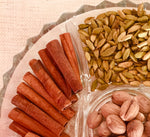

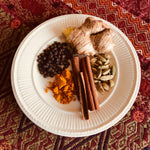






Comments